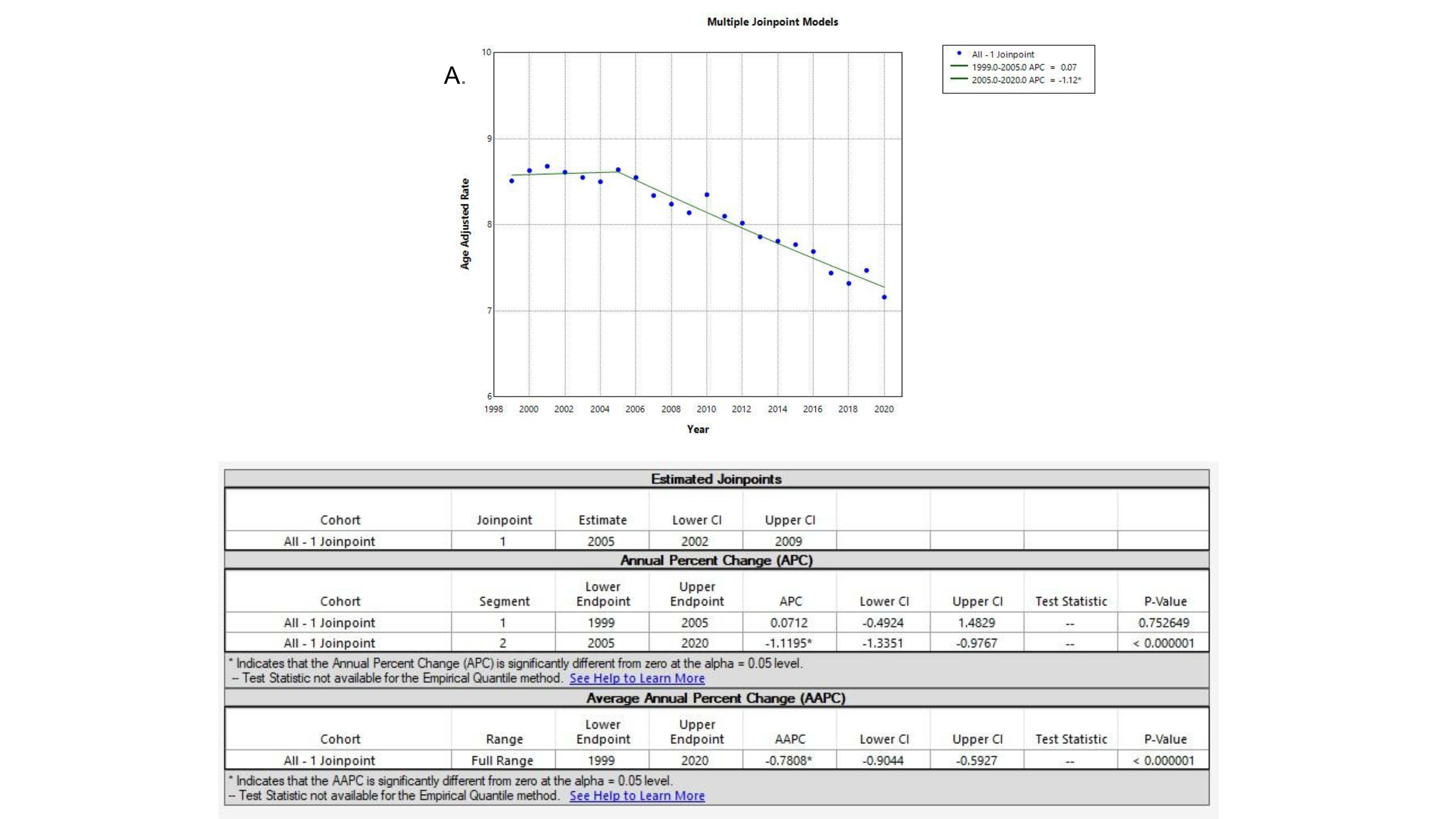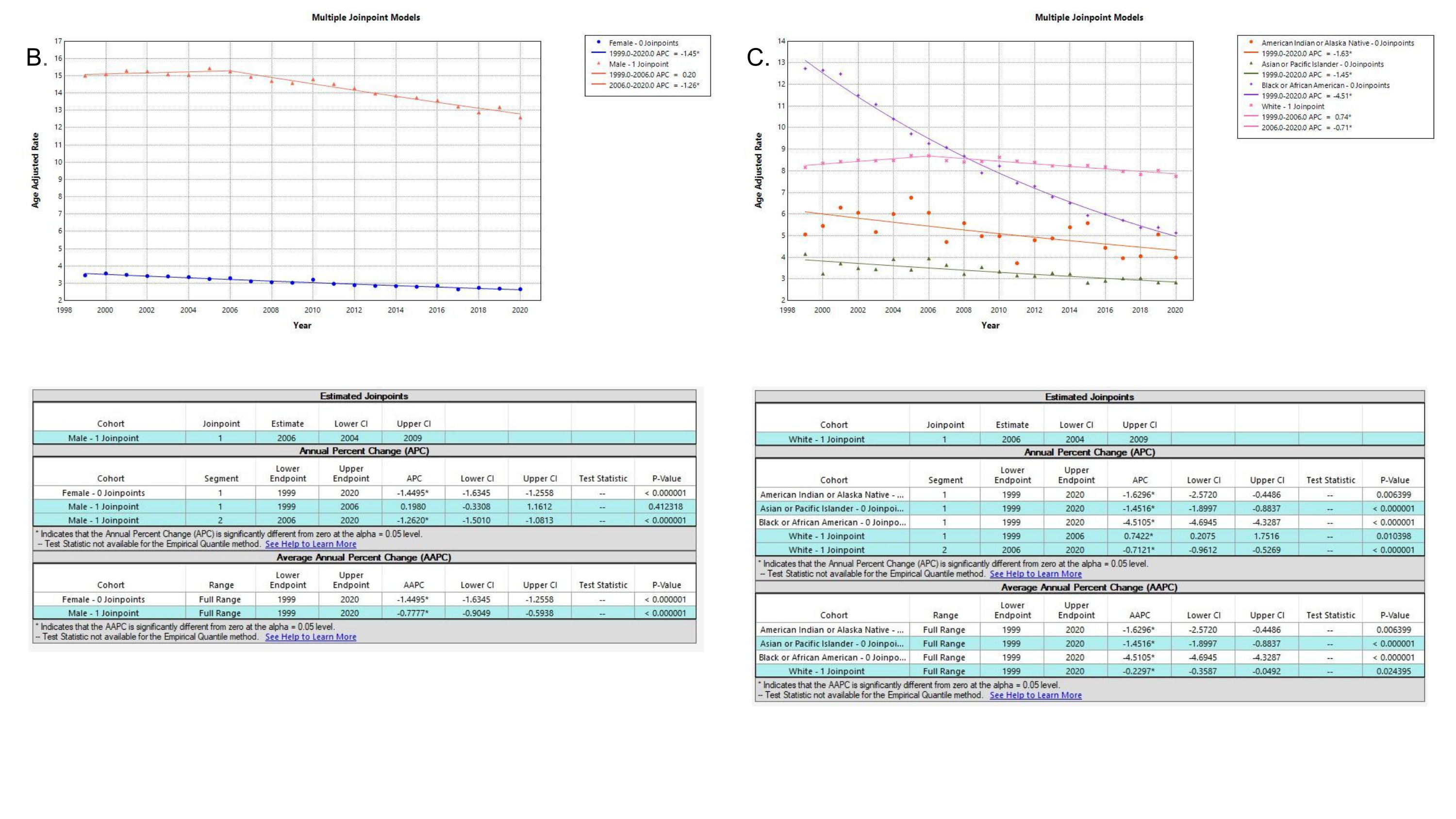Monday Poster Session
Category: Esophagus
P2814 - Temporal Trends in Esophageal Cancer Mortality in the United States by Year, Sex, and Race (1999-2020): A Population-Based Study
Monday, October 27, 2025
10:30 AM - 4:00 PM PDT
Location: Exhibit Hall
- SS
Shanthi Reddy Sripathi, MD (she/her/hers)
Einstein Medical Center
Philadelphia, PA
Presenting Author(s)
Shanthi Reddy Sripathi, MD1, Nikhil Kumar Balagoni, MBBS2, Rithik Naik Korra, MBBS2, Samiya Saher, MBBS2, Sana Rahman, MBBS2, Rithvika Rathod, MD3
1Einstein Medical Center, Philadelphia, PA; 2Osmania General Hospital and Medical College, Hyderabad, Telangana, India; 3Jersey City Medical Center, Jersey City, NJ
Introduction: Esophageal cancer is the fourth most common gastrointestinal cancer in the U.S., with significant mortality rates. This study aimed to assess temporal trends in esophageal cancer-related mortality among U.S. adults by year, sex, and race.
Methods: We used the CDC WONDER database to determine age-adjusted mortality rates (AAMRs) of esophageal cancer in the U.S. from 1999 to 2020 in adults aged ≥35. AAMRs per 100,000 were stratified by year, sex, and race. Statistical analysis, including regression and two-sample t-tests, was performed using MS Excel. Joinpoint regression was used to assess trends, reported as annual percentage change (APC) and average annual percentage change (AAPC). A p-value < 0.05 was considered statistically significant.
Results: Between 1999 and 2020, 309,054 esophageal cancer deaths were recorded, with an overall AAMR of 8.06 (95% CI: 8.03–8.08, p< 0.05). AAMRs declined from 8.51 in 1999 to 7.16 in 2020 (AAPC -0.78; 95% CI: -0.59 to -0.9, p< 0.000001). Males consistently had higher rates than females (14.28 vs. 3.05, p< 0.000001). While linear regression showed a steeper decline in males, Joinpoint analysis revealed a greater AAPC in females (-1.45 vs. -0.77, p< 0.000001), highlighting the importance of using segmented models to capture evolving trends.
Significant differences were also noticed across racial groups. Whites had the highest mean AAMR (8.26), followed by Blacks (7.97), American Indians (4.95), and Asians (3.23). Blacks initially had the highest mortality (12.73 in 1999) but saw a significant decline to 5.13 in 2020 (AAPC -4.51; 95% CI: -4.32 to -4.69, p< 0.000001). Whites showed persistently high rates with an increase from 8.16 in 1999 to 8.7 in 2006 (APC 0.74; 95% CI: 1.75 to 0.2, p< 0.01), followed by a modest decrease to 7.74 in 2020 (APC -0.71; 95% CI: -0.52 to -0.96, p< 0.000001). While Asians demonstrated persistently lower rates (AAPC -1.45; 95% CI: -0.88 to -1.89, p< 0.000001), American Indians showed more variable trends, likely due to smaller population sizes (AAPC -1.62; 95% CI: -0.44 to -2.57, p< 0.006).
Discussion: Esophageal cancer mortality has declined overall, but disparities by sex and race persist. Males had higher mortality, though females showed a steeper decline. Blacks demonstrated the greatest improvement, while Whites continued to have the highest mortality. These findings highlight the need for targeted interventions and the utility of Joinpoint regression in capturing temporal patterns often missed by linear models.

Figure: Joinpoint Regression Analysis of Esophageal Cancer Mortality Trends in the U.S., 1999–2020 (Stratified by Year)

Figure: Joinpoint Regression Analysis of Age-Adjusted Esophageal Cancer Mortality by Sex (B) and Race (C), 1999–2020
Disclosures:
Shanthi Reddy Sripathi indicated no relevant financial relationships.
Nikhil Kumar Balagoni indicated no relevant financial relationships.
Rithik Naik Korra indicated no relevant financial relationships.
Samiya Saher indicated no relevant financial relationships.
Sana Rahman indicated no relevant financial relationships.
Rithvika Rathod indicated no relevant financial relationships.
Shanthi Reddy Sripathi, MD1, Nikhil Kumar Balagoni, MBBS2, Rithik Naik Korra, MBBS2, Samiya Saher, MBBS2, Sana Rahman, MBBS2, Rithvika Rathod, MD3. P2814 - Temporal Trends in Esophageal Cancer Mortality in the United States by Year, Sex, and Race (1999-2020): A Population-Based Study, ACG 2025 Annual Scientific Meeting Abstracts. Phoenix, AZ: American College of Gastroenterology.
1Einstein Medical Center, Philadelphia, PA; 2Osmania General Hospital and Medical College, Hyderabad, Telangana, India; 3Jersey City Medical Center, Jersey City, NJ
Introduction: Esophageal cancer is the fourth most common gastrointestinal cancer in the U.S., with significant mortality rates. This study aimed to assess temporal trends in esophageal cancer-related mortality among U.S. adults by year, sex, and race.
Methods: We used the CDC WONDER database to determine age-adjusted mortality rates (AAMRs) of esophageal cancer in the U.S. from 1999 to 2020 in adults aged ≥35. AAMRs per 100,000 were stratified by year, sex, and race. Statistical analysis, including regression and two-sample t-tests, was performed using MS Excel. Joinpoint regression was used to assess trends, reported as annual percentage change (APC) and average annual percentage change (AAPC). A p-value < 0.05 was considered statistically significant.
Results: Between 1999 and 2020, 309,054 esophageal cancer deaths were recorded, with an overall AAMR of 8.06 (95% CI: 8.03–8.08, p< 0.05). AAMRs declined from 8.51 in 1999 to 7.16 in 2020 (AAPC -0.78; 95% CI: -0.59 to -0.9, p< 0.000001). Males consistently had higher rates than females (14.28 vs. 3.05, p< 0.000001). While linear regression showed a steeper decline in males, Joinpoint analysis revealed a greater AAPC in females (-1.45 vs. -0.77, p< 0.000001), highlighting the importance of using segmented models to capture evolving trends.
Significant differences were also noticed across racial groups. Whites had the highest mean AAMR (8.26), followed by Blacks (7.97), American Indians (4.95), and Asians (3.23). Blacks initially had the highest mortality (12.73 in 1999) but saw a significant decline to 5.13 in 2020 (AAPC -4.51; 95% CI: -4.32 to -4.69, p< 0.000001). Whites showed persistently high rates with an increase from 8.16 in 1999 to 8.7 in 2006 (APC 0.74; 95% CI: 1.75 to 0.2, p< 0.01), followed by a modest decrease to 7.74 in 2020 (APC -0.71; 95% CI: -0.52 to -0.96, p< 0.000001). While Asians demonstrated persistently lower rates (AAPC -1.45; 95% CI: -0.88 to -1.89, p< 0.000001), American Indians showed more variable trends, likely due to smaller population sizes (AAPC -1.62; 95% CI: -0.44 to -2.57, p< 0.006).
Discussion: Esophageal cancer mortality has declined overall, but disparities by sex and race persist. Males had higher mortality, though females showed a steeper decline. Blacks demonstrated the greatest improvement, while Whites continued to have the highest mortality. These findings highlight the need for targeted interventions and the utility of Joinpoint regression in capturing temporal patterns often missed by linear models.

Figure: Joinpoint Regression Analysis of Esophageal Cancer Mortality Trends in the U.S., 1999–2020 (Stratified by Year)

Figure: Joinpoint Regression Analysis of Age-Adjusted Esophageal Cancer Mortality by Sex (B) and Race (C), 1999–2020
Disclosures:
Shanthi Reddy Sripathi indicated no relevant financial relationships.
Nikhil Kumar Balagoni indicated no relevant financial relationships.
Rithik Naik Korra indicated no relevant financial relationships.
Samiya Saher indicated no relevant financial relationships.
Sana Rahman indicated no relevant financial relationships.
Rithvika Rathod indicated no relevant financial relationships.
Shanthi Reddy Sripathi, MD1, Nikhil Kumar Balagoni, MBBS2, Rithik Naik Korra, MBBS2, Samiya Saher, MBBS2, Sana Rahman, MBBS2, Rithvika Rathod, MD3. P2814 - Temporal Trends in Esophageal Cancer Mortality in the United States by Year, Sex, and Race (1999-2020): A Population-Based Study, ACG 2025 Annual Scientific Meeting Abstracts. Phoenix, AZ: American College of Gastroenterology.
